Konica (I), II and III
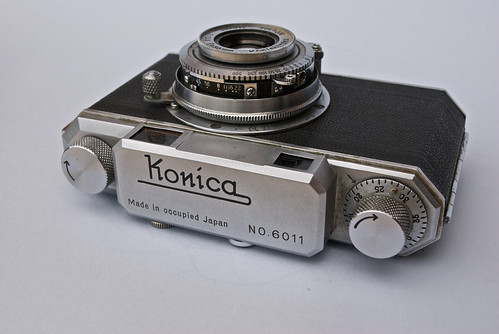
|
| Early "MIOJ" Konica (I) rangefinder image by Dirk HR Spennemann (Image rights) |
The Konica (or Konica I) and its successors the Konica II, and Konica III are fixed-lens, leaf-shutter rangefinder 35mm (24×36mm) cameras that Konishiroku made from 1947 until 1959 or 1960.
Contents
Rubikon and Rubicon
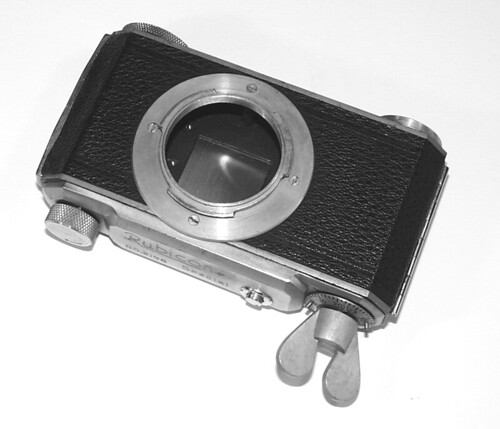
|
| Rubicon Special X-Ray camera (without Luminon 50mm f/1.6 lens), 1940/wartime model with "Wing Nut" film advance. image by Alan Myers (Image rights) |
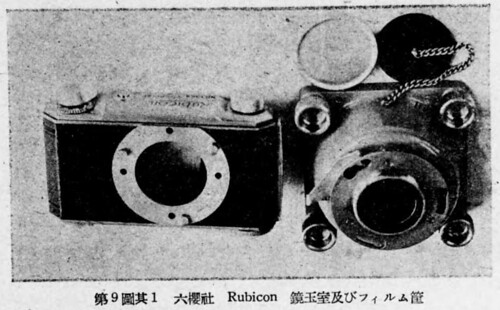
|
| Rubicon Special X-Ray camera (Image from エックス線間接撮影 (1943) by 横倉誠次郎). image by National Diet Library (Japan) Digital Library from Meiji Era (Image rights) |
The Konica was based on an earlier camera called Rubikon, developed by Konishiroku for general purpose photography from c.1938.[1] It was not commercially released and its development was stopped at some point in the late 1930s, because priority was given to the production of aerial cameras for the war effort.[2]
This camera is extremely similar to the Konica, and even the smaller parts show little difference. The top cover is inscribed Rokuoh-sha and Rubikon and has a serial number. At least one prototype is known with a Hexar Ser.IIB 50mm f/3.5 lens (no.3001) and a Compur-Rapid shutter (T, B, 1–500).[3] Others are reported, mostly with a Hexar lens, and sometimes with a different shutter.source needed Some of these might still exist today.[4]
The basic body chassis of the Rubikon was used for a specialized camera for X-ray photography, called Rubicon (with a "c" rather than a "k"), released in late 1940 together with the Sakura X-ray film.[5] This has no finder and uses a dark slide to control exposure, instead of a true shutter (X-ray exposures were rather longer than film exposures, and didn't need to be as precise). The Rubicon X-Ray camera comes in several variants — one with a knob to advance the film,source needed another with a "wing nut" film advance. Most were fitted with a male bayonet mount, to which a Luminon 50mm f/1.6 lens is attached.[6]
With its potential medical applications, the production of the Rubicon X-ray camera certainly continued during the war. The original model was made until 1950, when it was replaced by the Rubicon II, with a chain-driven advance knob, a rewind crank and a differently placed exposure counter.
The close similarities with the later 35mm film models are fairly obvious in the basic chassis, looking at the Rubicon photo to the right. Note the lack of any viewfinder and the shallower top cover. Not visible from this angle is the dark slide, which protrudes from the bottom of the camera and is simply pulled out to make an exposure. The button on the top is pressed to allow the film to advance (similar is used on the first models of the 35mm film camera).
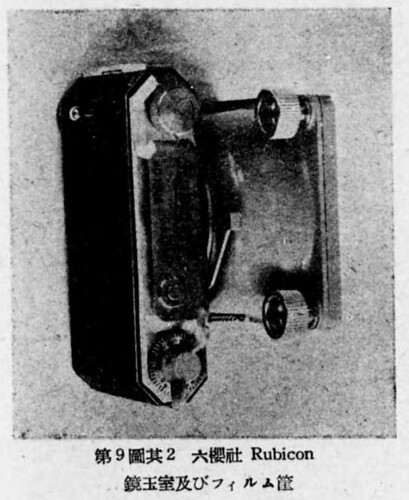
|
| Rubicon Special X-Ray camera (Image from エックス線間接撮影 (1943) by 横倉誠次郎). image by National Diet Library (Japan) Digital Library from Meiji Era (Image rights) |
Konica series

|
| Konica (I), 1950 model, Hexar f/2.8 lens, Konirapid shutter image by Inspiredphotos (Image rights) |
After the war during the occupation, production of the film camera was restarted and the name Konica was chosen to be used instead.
Similarly to "Leica", "Yashica" and many others, the name "Konica" was constructed by abbreviating the name of the manufacturer and suffixing "ca" (for "camera"). It would only later become the name of the company too.
Throughout the period when it was manufactured and sold, the Konica was the only camera for 135 film from Konishiroku, although the company also made the Konilette (earlier clamshell models) for paper-backed, unperforated 35mm film. Meanwhile, the main product for 120 film was the Pearl, and even the numbering of the Konica and Pearl seem to have gone up together.[7] Total production of the Konica (I) through the IIIM exceeded four hundred thousand.[8]
The Konica models dealt with here were followed by the Konica S, and its successors: very much 1960s designs.
Konica (I)
The Konica (later known as the Konica I or Konica Standard) is a knob-wound camera with a single eyepiece for the coupled rangefinder and viewfinder. It has a 50mm Konishiroku lens and a Konirapid shutter with speeds B, 1–500. The only shutter release is on the lens barrel, which also has a lever for cocking the shutter. The top of the camera is inscribed Konica (with the tail of the "a" hooking back to the "K" and beyond) and the number.
The dimensions are 132×80×65 mm and weight is 580g.[9]
 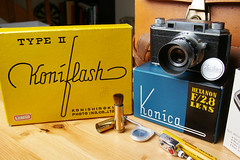 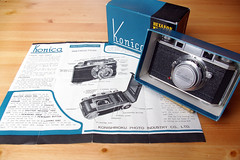
|
| Konica I, Hexanon f/2.8 lens, Konirapid-S shutter. Set with original box, instruction manual and Koniflash Type II flash gun images by Erich Z (Image rights) |
Something of the order of a hundred thousand Konica (I) cameras were sold.[10]
At least one company (not Konishiroku) offered a conversion that added a device akin to a body release: the new button is at the level of and immediately in front of the top plate; it operates a lever that pushes down the button on the lens barrel.[11]
There are a number of variants known, that can be readily identified using on the following flow chart.

|
| Konica (I), Typology of Versions. (Image rights) |
Types denoted with an asterisk (*) can be further distinguished by type of lens (2.8 or 3.5) and whether the distance scale is in metres or feet. Eg the notation IC/2.8m stands for “Konica I, type C with f2.8 lens and scale in metres.”
Konica I Type Ab
Introduced in August 1947[12] The top plate of the camera carries the serial number, the model name (‘Konica’) and the inscription ‘Made in Occupied Japan.’ The leatherette on the back door shows the name ‘Konishiroku’ embossed in ornamental letters, while the leatherette on the bottom is blank. The camera was fitted with collapsible f/3.5 Hexar (four elements in three groups) lens set in a Konirapid shutter with a black face and lettering picked out in silver. The lens has a 26mm outer diameter. The focussing scale is in metres. The price was ¥19,400.
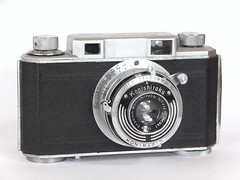 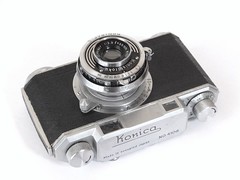 
|
| 1946/1947 Konishiroku Japan Konica-I (Early type). Hexar f3.5/50mm Lens. Images by yalluflex. (Image rights) |
Konica I Type As
Introduced in late 1947. The camera is identical in appearance to the Type Ab, with a Hexar f3.5 lens set in a Konirapid shutter BUT with a silver face with lettering picked out in black (as are all subsequent models). The lens has a 32mm outer diameter.
Konica I Type B
Introduced in March 1948. The top plate of the camera now carries the serial number, the model name (‘Konica’). The leatherette on the back door still shows the name ‘Konishiroku’ embossed in ornamental letters, while the leatherette on the bottom is now embossed with the inscription ‘Made in Occupied Japan.’[13] The camera was fitted with a Hexar f3.5 lens set in a Konirapid shutter. Part way through the production run of this variant, a Hexar f2.8 version was also made available. Both were sold concurrently. The focusing scale is still in meters. One example Konica lB (sn 16642). Possible marking of Katakana Japanese script on rewind knob = CPO or Central Purchasing Office of Allied Command.
Konica I Type C
Introduced sometime in 1949. The camera is identical in appearance to Type B, but lacking the name ‘Konishiroku’ embossed the back door. It was fitted with the two Hexar lens options already available for Type B (Hexar 2.8[14] and 3.5).[15] Tests of the camera were published around 1948[16] and it was advertised in magazines dated June 1948 through June 1950.[17]
Konica I Type Cs
The camera is identical in appearance to Type C, but from now on the lenses are set in the synchronised Konirapid-S shutter (B, 1–500). [18]
Konica I Type D
Introduced in 1950. The camera is identical in appearance to Type C, except that the text on the camera bottom now reads ‘Made in Japan.’ It would appear that the version with the Hexar f/3.5 was sold concurrently with Type E, which had the Hexanon f/2.8 mounted.
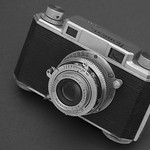
|
| Type E image by Casual Camera Collector (Image rights) |
Konica I Type E
Introduced in August 1950. The camera is similar in appearance to Type D. The main change was the introduction of the Hexanon f/2.8 lens. Units with distances marked in feet were made for the US market. It was advertised in magazines dated August 1950 through January 1951.[19]
Konica I Type F
The camera is identical in appearance and technical details to Type D. The only difference is that ‘Made in Japan’ is now engraved on the metal door lock wheel instead of being embossed in the bottom leatherette.
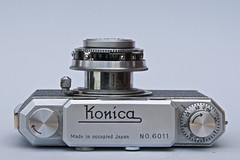 Top Plate, Type Ab and As |
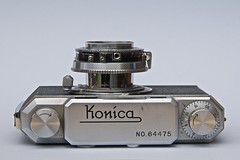 Top Plate, Types B to F |
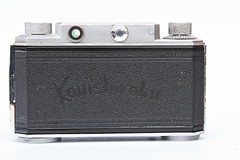 Camera Back, Types A & B |
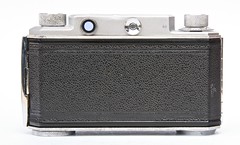 Camera Back, Types C to F |
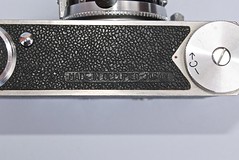 Inscription, Types B to C |
 Inscription, Types D to E |
 Serial number of shutter |
 Lens tube locking instructions |
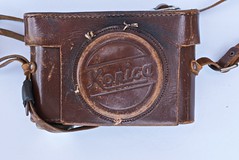 Leather Case, Types A & B |
 Leather Case, Type C to F |
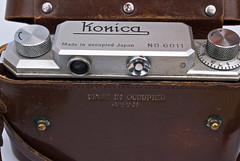 Leather Case, Types A & B |
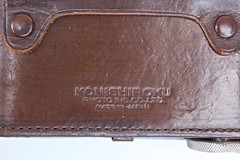 Leather Case, Type C to F |
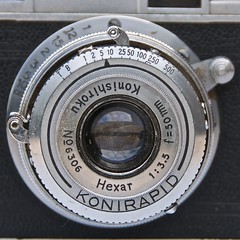 Hexar f/3.5 in Konirapid |
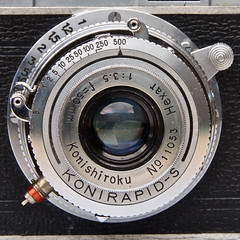 Hexar f/3.5 in Konirapid-S |
 Hexar f/2.8 in Konirapid-S |
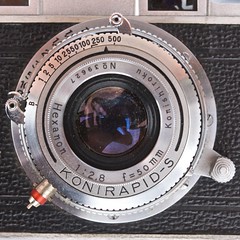 Hexanon f/2.8 in Konirapid-S |
Distinguishing characteristics of the various Konica (I) types
Images by Dirk HR Spennemann (Image rights)
Konica II
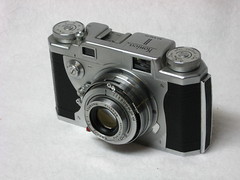 ] ]
|
| Konica II no. 44678, Hexanon f/2.8 lens no.95712, Konirapid-S shutter image by Mark O'Brien (Image rights) |
The Konica II (from 1951) continues to use a retractable lens, though now it's trimmed out with a curvaceous bright metal bezel surrounding the Konirapid-S shutter (later updated) and Hexanon 50mm f/2.8 lens. New to the model is a an accessory cold shoe and a shutter release button on top of the camera. Positive accidental double exposure prevention is added on this model and subsequent... Firing the shutter allows the film to be wound further and prevents the shutter from being cocked and fired again unless the film is wound. This was a sorely missed feature on the Konica "I", where it was far too easy to make accidental double exposures. It is still possible to make deliberate double exposures, utilizing the secondary shutter release lever on the shutter itself.
Together with the later models (the Konica IIA, IIB, etc.), the Konica II looks very different from earlier and later models, though upon close inspection it should be noted that the same basic chassis as the Konica "I" used. The circular lens mount is not attached directly to the leather of the body covering as on the Konica (I); instead, it is attached to a metal plate mounted over the leather, a plate extending from the top housing to the bottom plate and whose sides are curved. Likely this was done in part to improve servicability, as well as for it's aesthetic appeal. (The Konica III models would retain a bezel but though smaller and less curvaceous. It was also a functional consideration on those models, with their relocated film winding/shutter charging levers. See below.)
The view from the top shows the expected film advance on the right, incorporating the frame counter, and the rewind knob on the left, doubling as a film reminder. The shutter release button, new to this model, is close to the film advance knob and toward the front. Normally, the shutter releade button is capped with a small finisher that hides the threads to attach cable release, self-timer or other accessories, seen in the images of this model above. It's not uncommon for this finishing cap to be lost. It's quite small once removed. When installed, it makes for nice touch (there are so-called "soft touch" oversize shutter release accessory caps that serve similar purpose). The shutter charging lever is visible in the camera's viewfinder when the shutter is uncocked, and not visible when the shutter is charged and the camera is ready to use. This makes for a simple reminder to the user. Little details like these give some clue the thought and care Konishiroku gave to the design and finish of their camers. The accessory cold shoe is slightly to the right of centre, and is sized to fit standard flash and other accessories. The top of the housing is inscribed Konica (again with a decorative end to the "a") and below this, and in much taller lettering, either II (for all the models discussed in this section other than the IIA) or IIA.
Viewed from the front, just within the top left extremity of the curvacious metal plate is, on II and IIA is a knob with two positions: "I" and "T". This is not a self timer. These are "Instant" and "Time" settings. The "I" setting is used most of the time, enabling the shutter speeds from 1s to 1/500s and B on the shutter to be used. The "T" setting is for longer exposures and differs from B or Bulb, though both are used for long exposures. In "T" you press the shutter release button once to open the shutter, then a second time to close it. On "B" you need to hold the shutter release button down continuously to make a long exposure.
On the II and subsequent IIA model, toward its bottom is inscribed 24X36. (On IIB, IIB-m this is omitted.)
The appearance of the camera is slick and modern — 1950s rather than 1940s — with a series of smart improvements over the original Koinica, though the camera remains knob wound/rewound and retains a number of the now-quaint features of the day.
Initially the II offers a K-style flash connection post. Part way through production this was changed to the now more common PC-type connector.
The II model might have continued production, being offered alongside all the models, as the premium model a step above the IIB and IIB-m, until it became second tier to the IIA. There is some dispute about a later model some call II"F", though no examples have been show labelled in this way. Another school of thought is that the II simply continued in production and got an updated shutter about the time the IIA was offed as a more premium model.
The dimensions are 132×77×59 mm and weight is 685g.[20] Sales of the Konica II and its variants totaled over 120,000.[21]
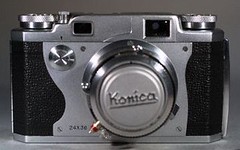  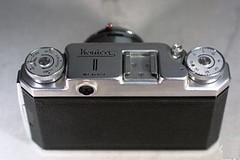
|

|

| |
| Konica II no. 414x4, Hexanon 50mm f/2.8 lens no. 68933, Konirapid-S shutter images courtesy of Reid at Pardees Camera (Image rights) | |
The original Konica II, released in December 1951, has a 50mm f/2.8 Hexanon lens (five elements in three groups) and a Konirapid-S shutter (T, B, 1–500). It is inscribed 24X36.[22] It was priced at ¥38,000 and advertised in magazines dated from February 1952 till February 1955.[23]
The Konica IIB is a cheaper version. The lens is a 50mm Hexar rather than Hexanon, whose aperture is either f/3.5 (from May 1955) or f/2.8 (from June 1955); The Time mode is no longer an option on the shutter and the I/T knob on the II is here replaced by a round cover marked Konica B. However, the shutter is still the Konirapid-S, with the full range of shutter speeds 1s to 1/500s, plus B. The IIB lacks the 24X36 inscription.[24] It was advertised in magazines dated August–December 1955, and priced at ¥27,000.[25]
The Konica II"F" or late Konica II(February 1956) continues to use a 50mm f/2.8 Hexanon lens, but now in a Konirapid-MFX shutter. Otherwise it is the same as the original II, so there is some dispute whether this should be considered a separate model. No examples have been shown that are actually labelled II"F". All purporting to be II"F" are merely imprinted "Konica II". II"F" also is not documented in any known Konica literature or mentioned in ads and writings from the day. Konica historians don't mention a distinct model either. Rather this might be a simple and minor update of the original II, with the new Konirapid-MFX shutter instead of the Konirapid-S. [26]
The Konica IIA (March 1956) is a new top-of-the-line model with a fine new lens. Like the late II (or II"F"), it uses the new Konirapid-MFX shutter, too. The IIA is the first model to be fitted with the very well regarded 48mm f/2 Hexanon (six elements in five groups). The lens on IIA is fixed, not retractable as it was on earlier models. A minor detail of this is that I and T are inscribed on the plate outside the self-timer knob; one turns the knob so that its index mark matches one or the other.</ref> The top plate is inscribed Konica IIA, as noted above. It was advertised in magazines dated April and May 1956, and priced at ¥35,000.[27]
The Konica IIBm (February 1957) is a revision of the IIB. The lens is now a 45mm f/3.5 Hexar, and the shutter a Seikosha-MX (B, 1–500). The cover replacing the self-timer knob is marked IIB-m (with no mention of Konica). It was advertised in magazines dated November 1956 until March 1957, and priced at ¥22,500.[28]
The distinctive external appearance of the Konica II was shamelessly aped by Tōkyō Kōken for its Dolca 35 II.[29]
Interchangeable-lens prototype
Inspired by the Kodak Retina IIc and IIIc in early 1954, Konishiroku worked on an interchangeable-lens model that doesn't seem to have been given a model name of its own, but is based upon Konica II. It had interchangeable Hexanon 50/1.9 and 85/3.5 lens heads (and possibly a third, as yet unknown focal length), all sharing a fixed section from the shutter and rearward. This design allows using a leaf shutter, rather than a focal plane. Besides the Kodaks, there were Zeiss Ikon and others offering similar during the 1950s and eary 60s. This prototype was displayed in an exhibition of future products held by the company from October 21 in three Tokyo department stores, simultaneously with the teleconverter for the Koniflex TLR and various lenses in Leica screw mount. This implies that several were made, but it never went into full production. All the information about this prototype is from Miyazaki, pp.29–30. Hagiya, p.130 of Sekai no Raika renzu, specifies that the exhibition of future products took place in three department stores, perhaps implying that several prototypes were completed. He also says that "three types of interchangeable lenses for a 35mm leaf shutter camera" were displayed, implying that there was a third lens option. No such prototype (and indeed no Konishiroku prototype from before 1957) was exhibited in the Konica Minolta exhibition held at the JCII Camera Museum in 2005, so presumably no prototype remains in the possession of Konica Minolta (or Sony). This un-named prototype based upon the Konica II series cameras should not be confused with the somewhat later (1960-61) Konica FR based upon the Konica S and utilizing interchangeable Leica screwmount (LTM) lenses.
Konica III
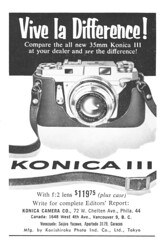
|
| Konica III. Advertisement in National Geographic, May 1957 (Image rights) |
The Konica III (from 1956) is a considerable advance from the Konica II: the shutter is cocked by the film advance.
The Konica III (as well as the IIIA and IIIM, discussed below) is immediately distinguishable from the Konica II (and all its variations) thanks to the film wind lever, which is not on the top but instead on the front of the camera and invites the use of the forefinger (or thumb) of the photographer's left hand (similar to that on the Adox 300 and Zeiss Tenax). This lever needs two strokes and cocks the shutter at the same time as it winds the film. The curvaceous metal plate between leather and lens on the II is reduced and made more rectangular. The self-timer control (where present) becomes a lever and the film rewind knob also has a fold-out crank, both of the kind then becoming conventional. The top cover is engraved Konica, below this (and much taller) III, and below this (and much smaller) NO. and the serial number. Each model has a 48mm Hexanon lens (six elements in five groups).
The dimensions are 132×80×64 mm and weight is 760g.[30]
Sales of the Konica III and its variants (including the IIIA and IIIM) totaled over 170,000.[31]
The original Konica III (or Konica IIIMFX, September 1956) has an f/2 lens (six elements in five groups) with Konirapid MFX shutter (B, 1–500). It cost ¥34,500, including case[32] or $119.75.[33] It weighs 750g.[34]
The Konica IIIL (or Konica IIIMXL, April 1957) has a Seikosha MXL shutter, with the then-popular light-value system. Quite aside from the arguable irritations of the LV interlock, this particular implementation is rather half-baked as the LV setting itself is on the bottom of the lens barrel, so the camera must be inverted in order to adjust it. The optical design of the lens is unchanged. It was introduced in the Japanese magazines dated June to August 1957.
All the subsequent models too would have Seikosha shutters: Konishiroku, like smaller companies making shutters, realized it could not compete with the quality and scale of Seikosha and Copal.[35]
Not surprisingly, a Konica IIIL2 (or Konica IIIMXL2) succeeded the IIIL, with the LV setting on the top rather than bottom of the lens barrel. It was introduced in the magazines dated January and February 1958.
A cheaper version of the IIIL2 has an f/2.4 lens and no self timer (March 1958). (This is the least common of the variants of the III.[36]) It was introduced in the magazines dated May 1958.
Konica IIIA and IIIM
While the nomenclature of Konica's next pair of cameras suggests that neither differed from the III more than, say, the IIA differed from the II, they are improved so dramatically as to be considered separately, perhaps would have been better named models IV and V.[37] The two models were available simultaneously, for ¥32,800 and ¥34,800 respectively, including case.[38]
The major change is to the finder, greatly enlarged and with projecting framelines that adjust not only for parallax but also for the variation in the lens's angle of view when focused closer.
This larger finder necessitates a higher top cover, such that the rewind crank of the III would foul it if not radically redesigned. The crank is therefore stepped.
Konica IIIA

|
| Konica IIIA image by thomas@flickr (Image rights) |
When viewed from the front, the Konica IIIA (April 1958) has three finder windows, of which the viewfinder is fairly large even by today's standards. The three are for the rangefinder, projected brightlines, and viewfinder (and rangefinder) respectively.
The finder has 1.0× magnification, such that the photographer can easily look through it with right eye while keeping the left eye open. The lens is a 48mm f/2 Hexanon, with LV system; filter size 35.5mm. Dimensions are 133×81×65mm; weight 800g.[39]
In July 1958 came the option of a 50mm f/1.8 Hexanon (70mm deep, weight 820g).[40]
Malcolm X had a Konica IIIA.[41]
Konica IIIM
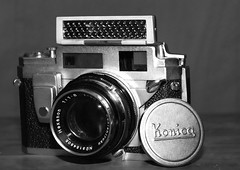
|
| Konica IIIM image by Sam DeFalco (Image rights) |
The Konica IIIM (March 1959) adds an exposure meter and half-frame capability to the faster (50/1.8) version of the IIIA - the self timer is moved to the side of the lens barrel.
The meter accounts for two add-ons: a device attached close to where the self-timer is on the III, and a flap hinged across the top that closes a set of selenium cells against the finder windows when the camera is not in use and opens them over the front when it is in use.
The IIIM also came with a mask for half-frame photography. Inserting this and sliding a lever above the film take-up spool switches the camera to the appropriate film spacing and frame-counting systems.
The finder windows are redesigned, such that two large windows appear.
The IIIM is the first Konica rangefinder camera to feature a built-in hot shoe for flash, but it is a non-standard type of unusual dimensions that cannot be used with most flashes. Konishiroku offered a Koniflash IIIM especially for the camera. That's a compact flash bulb holder with folding fan-type reflector.
The IIIM cost ¥36,500, including case.[42]
Notes
- ↑ Miyazaki, p.14.
- ↑ Miyazaki, p.14.
- ↑ Example pictured in Miyazaki, p.16.
- ↑ Miyazaki, p.14, says that one or more prototypes were kept by the company after the development was stopped, and that they were used after the war to develop the Konica, but this does not imply that these still exist today.
- ↑ Spennemann, Dirk H.R. (2016) History and Documentation of the Rubicon x-Ray camera, manufactured by Rokuoh-Sha (1938–1944) and Konishiroku (1946–1960). Konishi Cameras (小西 カメラ) nº 11.1 (Albury NSW).
- ↑ Luminon 50mm f/1.6: Miyazaki, p.14. The bayonet mount and Luminon lens are pictured on p.15.
- ↑ Simplified sequence: Semi Pearl, Konica (I), Pearl (I), Konica II, Pearl II, Pearl III, Konica III, Konica IIIA, Pearl IV, Konica IIIM. Other Konishiroku cameras of the period were limited to the Snappy subminiature and the Koniflex TLR. (Konishiroku was also making lenses for Leica-mount cameras, notably the Honor.) The SLR cameras would start a little later.
- ↑ Miyazaki, p. 37.
- ↑ Figures are for the Konica I with f/3.5 lens, silver plate. Source: Itō, "Konica I", p.59.
- ↑ Figure obtained by subtracting Miyazaki's figures for the II and subsequent models from the figure for the whole series.
- ↑ Depicted in Miyazaki, p.23.
- ↑ Unless noted otherwise, all month–year references in this article are to the initial sale within Japan and are derived from Miyazaki.
- ↑ At least one camera is known (sn 8553) where the embossing on the bottom is lacking. This may well represent production error.
- ↑ The depth of the camera with a Hexar f2.8 is 68.5mm, weight 620g, and price ¥23,800
- ↑ It was advertised as Synchro Konica (シンクロコニカ, shinkuro konika), but still simply inscribed Konica
- ↑ According to Kokusan kamera no rekishi, p.351: Ars Camera, November 1948; Kōga Gekkan, February 1947 and March 1948; Shashin Salon, January 1953 (comparative evaluation); etc.
- ↑ Kokusan kamera no rekishi, p.359.
- ↑ It was advertised as Synchro Konica (シンクロコニカ, shinkuro konika), but still simply inscribed Konica
- ↑ Kokusan kamera no rekishi, p.359.
- ↑ Figures are for the original Konica II. Source: Itō, "Konica II", p.114.
- ↑ Miyazaki, p. 26.
- ↑ Uniquely, T and I are marked on the self-timer knob itself: one turns this so one or other is aligned with a mark at the bottom of the top housing.
- ↑ Span of advertising: Kokusan kamera no rekishi. Price: Miyazaki, p.26.
- ↑ As does the IIBm. Sizes such as 24×32 and 24×34 were initially popular in Japan as a way to reduce the waste of film, but unpopular with American commercial film processors. Perhaps the cheaper versions of the Konica II were neither sold to the US military nor exported, but this is mere speculation. Regardless of the presence or absence of this inscription, all models have a frame size of 24×36mm.
- ↑ Asahi Camera, August 1955; reproduced in Kokusan kamera no rekishi, p.137. Price: Miyazaki, p.26.
- ↑ Miyazaki, p.29.
- ↑ Price: Miyazaki, p.26.
- ↑ Price: Miyazaki, p.26.
- ↑ As charmingly illustrated by Miyazaki, p.30, and in page by Nekosan (archived).
- ↑ Figures are for the Konica IIIL. Source: Itō, "Konica III", p.63.
- ↑ Miyazaki, p.31.
- ↑ Advertisement in Asahi Camera, special edition for summer 1957; reproduced in Kokusan kamera no rekishi, p.242.
- ↑ Advertisement in National Geographic, may 1957, p.566.
- ↑ Miyazaki, p.34.
- ↑ Miyazaki, p. 32 (although Miyazaki does not name Copal).
- ↑ Miyazaki, p. 34.
- ↑ This may be related to the well-known east Asian reluctance to number things (products, hotel floors, etc.) as four. But clearly any such reluctance wasn't overwhelmingly strong: note the Canon IV, and even the Pearl IV from Konishiroku itself.
- ↑ Advertisement in Asahi Camera, September 1958; reproduced in Kokusan kamera no rekishi, p.243.
- ↑ Hishida, p.76. In fact what Hishida writes is rather more complex: what looks like a set of typos — involving a variant IIIA that, without explanation, is 10mm wider than either this or the IIIM — has been regularized for this article.
- ↑ Hishida p.75.
- ↑ 'Beethoven was black': why the radical idea still has power today; the Guardian, 7 September 2020; picture by Bob Henriques, halfway down the page.
- ↑ Advertisement in Asahi Camera May 1959, reproduced in Kokusan kamera no rekishi, p.243.
Further reading
In English:
- Herz, Nat. Konica Pocket Handbook. New York: Verlan Books ("A Universal Photo Book"), 1960. A detailed guide to the Konica IIIA and IIIM, as well as the Konica S and 35mm photography in general. (The copy examined also has a separately paginated section, The Konica FS and Konica F: A Guide to Better Single-Lens Reflex Photography, covering the Konica FS and Konica F, bound within the same covers.)
- The Japanese Historical Camera. 2nd ed. Tokyo: JCII Camera Museum, 2004. P.83 (Konica IIA), p.84 (Konica III), p.93 (Konica IIIA), p.97 (Konica IIIM).
- Lewis, Gordon, ed. The History of the Japanese Camera. Rochester, N.Y.: George Eastman House, International Museum of Photography & Film, 1991. ISBN 0-935398-17-1 (paper), 0-935398-16-3 (hard). Pp. 62, 76, 94, 99, 101.
- Spennemann, Dirk H.R. (2016) History and Documentation of the Rubicon x-Ray camera, manufactured by Rokuoh-Sha (1938–1944) and Konishiroku (1946–1960). Konishi Cameras (小西 カメラ) nº 11.1 (Albury NSW).
In Japanese:
- Reports in Shashin Kōgyō on the Konica II: May 1952, May 1953, November 1953, April 1955.
- Report in Sankei Camera on the Konica IIA: May 1956.
- Test of the Konica III, Shashin Kōgyō October 1956.
- Test of the Konica III (with Seikosha-MXL shutter), as the first ever installment of "New Face Clinic", Asahi Camera, August 1957.
- Test of the Konica III, Shashin Salon, March 1958.
- Akiyama Seiji (秋山青磁). Konika no tsukaikata (コニカの使い方). Tokyo: Amico, 1950.
- Akiyama Seiji (秋山青磁). Atarashii Konika no tsukaikata (新しいコニカの使い方). Tokyo: Amico, 1955. On the Konica IIB.
- Asahi Camera (アサヒカメラ) editorial staff. Shōwa 10–40nen kōkoku ni miru kokusan kamera no rekishi (昭和10–40年広告にみる国産カメラの歴史, Japanese camera history as seen in advertisements, 1935–1965). Tokyo: Asahi Shinbunsha, 1994. ISBN 4-02-330312-7. Items 512–15, 1261–6.
- Hishida (菱田耕四郎). "Konica history 10: Sengo no kamera" (戦後のカメラ, Postwar cameras). Kamera Rebyū: Kurashikku Kamera Senka (カメラレビュー クラシックカメラ専科) / Camera Review: All about Historical Cameras no.10, September 1987. No ISBN number. Konishiroku kamera no rekishi (小西六カメラの歴史, special issue on Konishiroku). Pp.60–80.
- Itō Tsuguyoshi (伊藤ニ良). "Konika I" (コニカ I). Utsushite tanoshimu kurashikku kamera (写して楽しむクラシックカメラ). Tokyo: Shashinkogyo Syuppan-sha, 2001. ISBN 4879560636 Pp.59–62.
- Itō Tsuguyoshi (伊藤ニ良). "Konika II" (コニカ II). Utsushite tanoshimu kurashikku kamera 3 (写して楽しむクラシックカメラ 3). Tokyo: Shashinkogyo Syuppan-sha, 2005. ISBN 4879560742 Pp.114–19.
- Itō Tsuguyoshi (伊藤ニ良). "Konika III" (コニカ III). Utsushite tanoshimu kurashikku kamera (写して楽しむクラシックカメラ). Tokyo: Shashinkogyo Syuppan-sha, 2001. ISBN 4879560636 Pp.63–8.
- Iwama Tomohisa (岩間倶久). Konika no tsukaikata (コニカの使い方). Tokyo: Kōgasō, 1956.
- Konica Group. Konika III gata no tsukaikata (コニカIII形の使い方). Tokyo: Amico, 1957. Written by a group of Konishiroku employees.
- Konica Group. Konika IIIM no tsukaikata (コニカIIIMの使い方). Tokyo: Amico, 1959. Written by a group of Konishiroku employees.
- Konika-Minoruta-ten (コニカミノルタ展, Konica Minolta exhibition). Exhibition catalogue. Tokyo: JCII Camera Museum, 2005. P.10.
- Konishiroku Kamera no Rekishi (小西六カメラの歴史, History of Konishiroku cameras), vol. 10 (Autumn 1985 issue) of Kamera Rebyū Bessatsu: Kurashikku Kamera Senka / All about Historical Cameras.
- Miki Akira (三木旺), et al. Konika no kansei (コニカの完成). Tokyo: Amico, 1953. On the Konica II.
- Miyazaki Shigemoto (宮崎繁幹). Konika kamera no 50nen: Konika I-gata kara Hekisā RF e (コニカカメラの50年:コニカI型からヘキサーRFへ, Fifty years of Konica cameras: From the Konica I to the Hexar RF). Tokyo: Asahi Sonorama, 2003. ISBN 4-257-12038-X. Pp.18–57, 183.
- Photo Art rinji zōkan: Kamera akusesarī zensho (フォトアート臨時増刊・カメラアクセサリー全書, Photo Art special issue: All the camera accessories). June 1955, no.80 of the magazine. "Naigai kōkan renzu sōran" (内外交換レンズ総覧, Table and Japanese and foreign interchangeable lenses). Pp.78–9.
- Tanimura Yoshihiko (谷村吉彦). "Konika I" (コニカ I). Kamera Rebyū: Kurashikku Kamera Senka (カメラレビュー クラシックカメラ専科) / Camera Review: All about Historical Cameras no.35, November 1995. Nihon no kamera 50nen (日本のカメラ50年, special issue on 50 years of Japanese cameras). P.87.
- Tanimura Yoshihiko (谷村吉彦). "Konika IIIA" (コニカ IIIA). Kamera Rebyū: Kurashikku Kamera Senka (カメラレビュー クラシックカメラ専科) / Camera Review: All about Historical Cameras no.35, November 1995. Nihon no kamera 50nen (日本のカメラ50年, special issue on 50 years of Japanese cameras). P.94.
- Yoshikawa Hayao (吉川速男). Watakushi no Konica to gentō (私のコニカと幻燈, My Konica and slides). 1948.
Links
In English:
- Instructions for the Konica I, Konica IIB, and Konica III, at Mediajoy's Guide to Classic Cameras
- Konica IIA and Dolca 35 II compared in a page about wannabe cameras (archived) at Nekosan's website (archived)
- Konica III manual, from Michael Butkus
- Konica III M instruction manual in PDF at OrphanCameras.com
- Konica III, IIIA and IIIM, by Dante Stella
- Photo.Net thread on the Konica IIIA and another on the III and IIIA
- Konica III among 35mm cameras at Cameras Downunder
In French :
- Konica II, Konica III L2 on www.collection-appareils.fr by Sylvain Halgand
- JJ's French language page on the Konica IIIA (archived)
In Japanese:
- From エックス線間接撮影 by 横倉誠次郎 (1943):Picture and text about X-ray Rubicon at 近代デジタルライブラリー
- From the Konica Standard to the Konica IIIM, at matsumo's site (with more material than what's in the English version)
- Konica I, Konica IIBm and Konica III at Nobu-chan's classic camera page
- Konica I, IIB-m and IIIA at 一里家 (archived)
- Konica I (50mm f/3.5), Konica I (50mm f/2.8), Konica IIB, Konica IIA, Konica III MXL, Konica IIIA at Kenko Konica
- Konica I, Konica IIBm, Konica III, Konica IIIL2, and Konica IIIA at Range Finder (Fukucame)
- Konica I and more photos in Miyazawa Noriyuki's camera site
- Konica I in various posts [1] [2] [3] [4] [5] of the Junk Binbō blog
- Konica I and Konica II in a page of the AJCC website
- Konica I, Konica IIB, Konica III, Konica IIIA and Rubicon II at Japan Family Camera
- Konica II at Honky Tonk Junk (archived)
- Konica II in the first page of the Yamada Camera Museum
- Konica II at Shashin o tanoshimu
- Konica IIA (archived) in the Camera Mini Museum (archived) by Shinmatsu
- Konica IIA, Konica III, Konica IIIA, Konica IIIM in the Camera database of the Center of the History of Japanese Industrial Technology